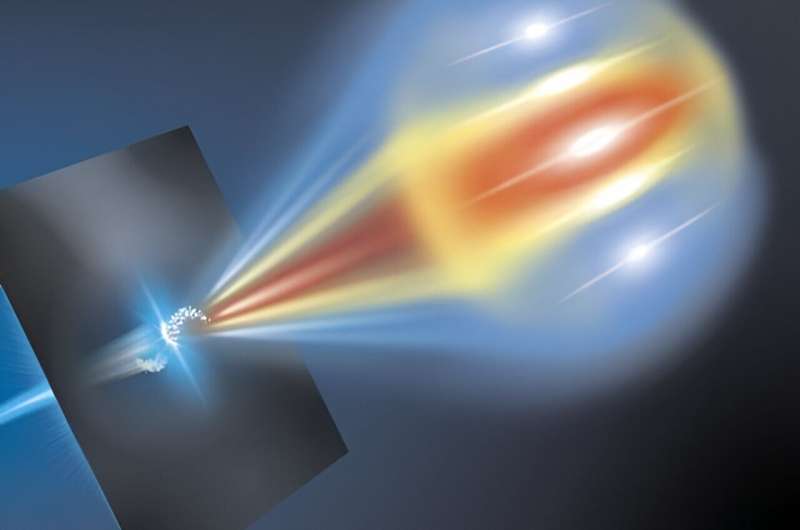
A structured beam of electron beams passes through a metal sheet from left to right, producing coherent optical transmission radiation. Credit: HZDR / Blaurock
Plasma laser accelerators occupy less space than conventional facilities that are sometimes kilometers long. Such compact particle sources can effectively accelerate electron bunches and power X-ray lasers housed in the basement of an academic institution.
But there are a few challenges: To produce ultraviolet or X-ray light, the electron bunches produced by the laser-plasma accelerator must be very fine and have specific properties.
To date, even these categories have been difficult to accurately measure. Now, a team at the Helmholtz-Zentrum Dresden-Rossendorf (HZDR) has developed a new measurement method that should help develop laser-plasma acceleration.
In laser-plasma acceleration, the laser emits intense light pulses into the gas. The pulse is so strong that it ionizes the gas and produces a plasma – a mixture of electrons and ions. As the laser pulse knocks the lighter electrons out of the way faster than the heavier ions, a positively charged “bubble” forms behind it. If some electrons are injected into this bubble, the strength of the electromagnetic field can effectively catapult them forward.
This process requires only a few centimeters, but it can accelerate bunched electrons to the size of a typical array that measures tens or even hundreds of meters and uses radio waves to propel the particles.
The free electron laser (FEL) is an interesting application for advanced plasma laser accelerators. Here, bunches of electrons pass through a so-called waveguide at nearly the speed of light. This array of magnets forces the particles into slalom tracks, causing them to emit strong, laser-like X-rays or ultraviolet light, which can be used to track extremely fast processes such as chemical reactions that take place in four billionths of a second.
Compact and affordable
There are now several such research machines, including the European XFEL in Hamburg. They are based on conventional linear accelerators, some of which are several kilometers long. But, so far, these facilities are rare and therefore available beam time is limited. If FELs could be built based on plasma laser accelerators, the facilities would be so compact and cost-effective that, for example, an academic institution could afford them. So this technology will be available to many more research teams than it is now.
Early successes have already been achieved: as of 2021, three research groups have succeeded in demonstrating that FELs based on plasma accelerators are feasible – a team in Shanghai, China, a group in Frascati, near Rome, and a team working with this physicist . Dr. Ari Erman at the HZDR Institute for Radiation Physics.
In a review article in the journal Photonics of naturepractitioners summarize the current state of development and detail outstanding research questions.
“Among other things, we need to improve the quality and stability of the accelerated electron bunches and minimize the energy distribution of the electrons in the bunches,” explains Ehrman, one of the authors of the paper. But it is also important to develop new diagnostic methods in order to more accurately investigate laser plasma accelerator processes.
The electron bunches pass through the foil
This is where the new HZDR project comes in: Dr. Maxwell LaBerge, a postdoctoral fellow in Airman’s team, has developed a measurement method that allows scientists to analyze in detail very short electron bunches measuring a few micrometers. The article has been published in the journal Photonics of nature.
“We shoot bunches of electrons at almost the speed of light from the plasma accelerator at a thin metal sheet. This propels the electrons on the surface of the foil,” explains LaBerge.
As a result, these electrons send a signal – instead of the transmitting antenna – that can be detected by sensors. “Using this signal, we can precisely reconstruct the shape of the electron bunches that passed through the foil,” says LaBerge, describing the process, whose technical term is coherent optical transfer radiation (COTR).
HZDR experts have used their new measurement method to discover different ways of injecting electrons into the plasma bubble. “We have been able to ascertain that different injection methods produce completely different shapes of electron bunches, indicating that the new method can help control the shape and structure of the electron bunches more precisely,” says Ehrman.
And the better the control over the fast electron bunches, the brighter and more stable the light they produce in the FEL.
More information:
M. Galletti et al., Prospects for free-electron lasers powered by accelerated plasma-wakefield beams, Photonics of nature (2024). DOI: 10.1038/s41566-024-01474-3
Maxwell LaBerge et al., Revealing the three-dimensional structure of fine plasma-Wakefield accelerated electron beams, Photonics of nature (2024). DOI: 10.1038/s41566-024-01475-2
Presented by the Helmholtz Association of German Research Centers
quote: Researchers present new diagnostic tool for plasma laser accelerator using metal foil as 3D scanner (2024, August 30) Retrieved September 3, 2024, from https://phys.org/news/2024-08-diagnostic-tool -laser-plasma-metal.html
This document is subject to copyright. Except for any fair dealing for the purpose of private study or research, no part may be reproduced without written permission. Content is provided for informational purposes only.
#Researchers #developed #diagnostic #tool #plasma #laser #accelerator #metal #foil #scanner